Unique Garden Solutions
Gardens created for unique circumstances are a lesson in adaptation
On this summer’s Manitoba Master Garden Association Garden Tour in Winnipeg, Manitoba, I discovered three special gardens – special in that they were built to deal with unique circumstances.
Two of the gardens were created amid flood protection landscapes. The third garden featured permaculture design, a natural landscaping design focused on working with nature to maximize biodiversity while minimizing human intervention.
The Red River Valley in south-central Manitoba is a flood plain. The term valley is a bit of a misnomer. The river has shallow banks and meanders through the middle of a vast agricultural plain. In some years, spring thaws and heavy rains on frozen or saturated ground result in significant flooding.
The Red River runs through the centre of Winnipeg. In the 1960s, the Red River Floodway was built to protect the city from flood damage. It is a long channel running around one side of the city, into which river water is diverted during flood periods. Many small towns in the area have dikes to protect them during floods. Rural properties outside of the city and towns must provide their own protection. Following the 1997 “Flood of the Century”, most rural residents raised, diked, or moved structures to reduce flood risk.
Garden 1, featured in the lead photograph above, is located just south of the Red River Floodway. The property was completely under water in 1997. After the flood, a dike was built encircling the house, garage, and yard. The dike has been incorporated into the landscape.
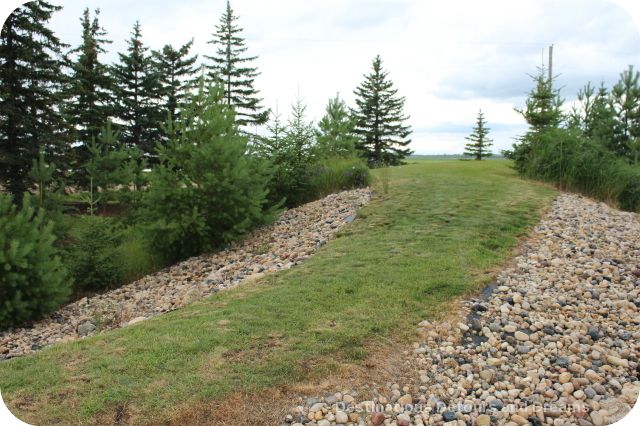
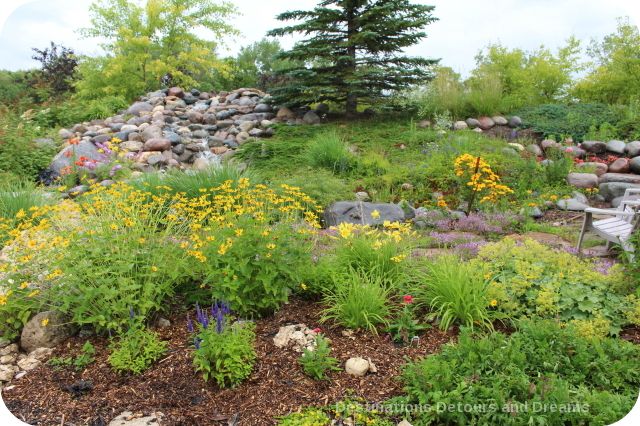
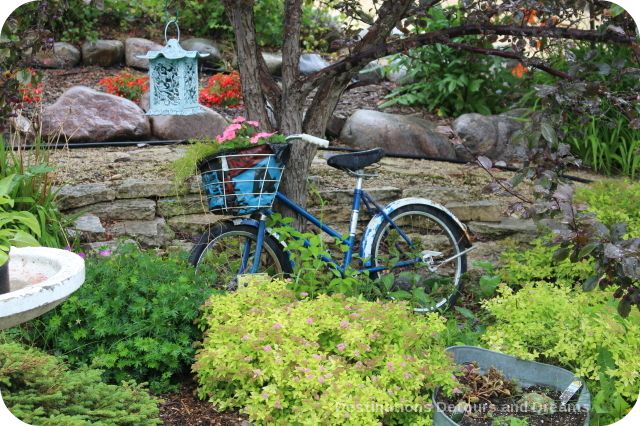
Behind and outside the dike is another yard, which includes a large grassy area, a playground, a pond, a raised garden for vegetables and cutting plants.
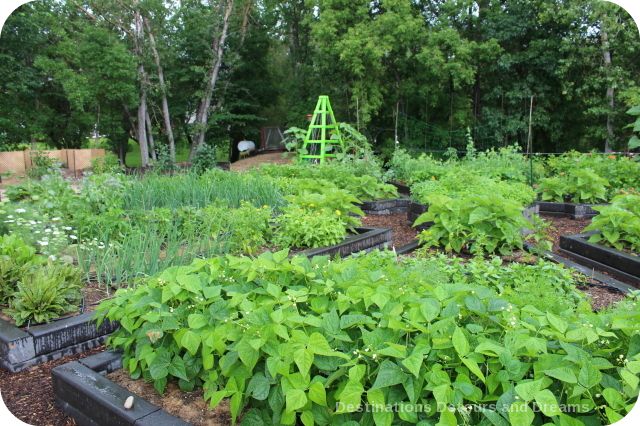
Instead of encasing their yard with a dike, the owners of Garden 2 opted to raise their house. The house now sits atop a hill and the gardens at the front and back slope down.
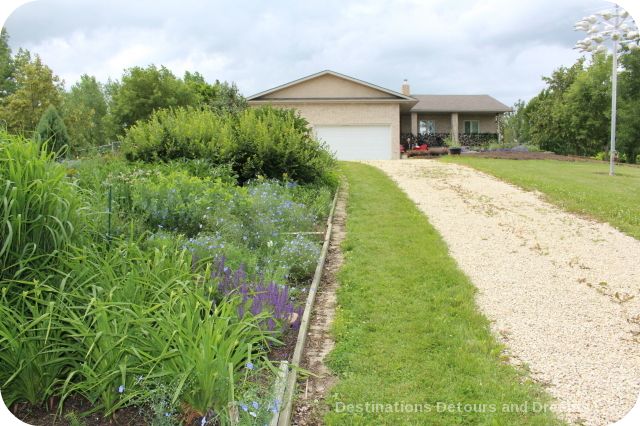
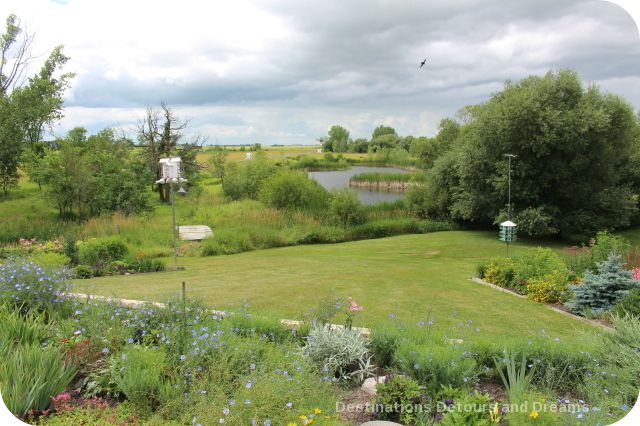
Garden 3 is within the city, in the Charleswood area. It was billed as a lasagna garden, the first time I had heard that term. A lasagna garden is a form of bed construction involving no digging and no removal or pre-killing of weeds.
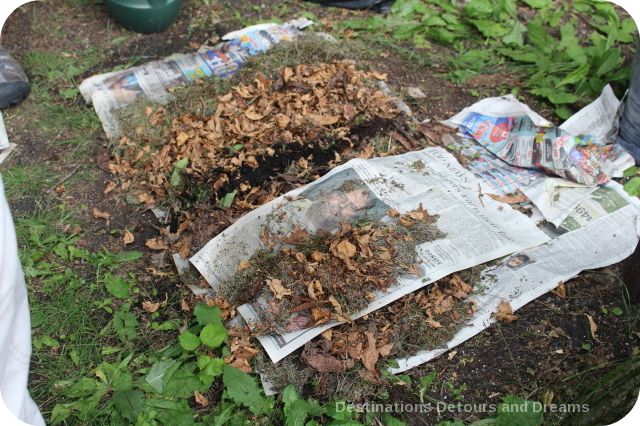
I listened to an explanation of how lasagna gardening works. You lay down overlapping, wet sheets of newspaper on the area where you wish to create a garden bed, followed by a layer of grass clippings or vegetable scraps (green layer), then a layer of brown, shredded leaves perhaps, followed by two or three more layers of green and brown. You may choose to add some topsoil at the end before you cover with mulch to preserve moisture. If you are covering an area with particularly invasive growth, you may wish to place non-waxed cardboard under the newspaper. Then you wait for nature to create humus-rich soil.
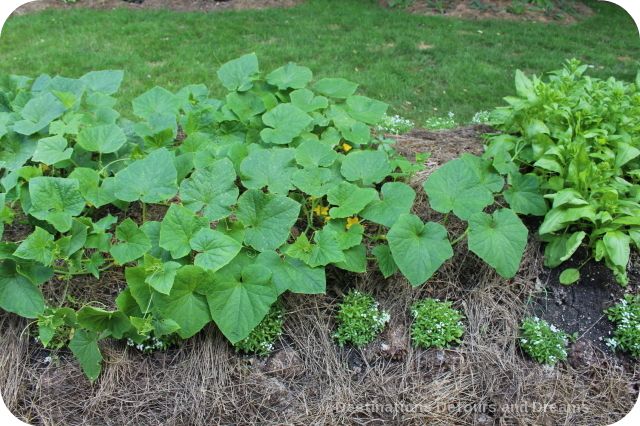
(I’ve also heard that mice stay away from flax straw.)
The owner of the garden had constructed the most recent of her beds in fall. This spring she planted only annuals in that bed, because their roots are shallow and the roots of the grass and weeds under the newspaper were likely not dead yet. By next summer, she will start planting perennials. She told me when she lived in southern Ontario, where winters are milder, it took only a few months for material in the lasagna beds to break down. Here it takes two years.
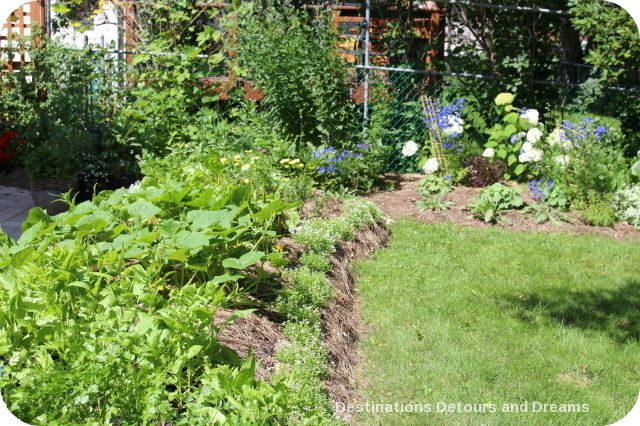
The bed at the back is lower and more established.
The gardener says that permaculture gardens require knowledge to plan and work to construct, but once they are established they are fairly self-sustaining.
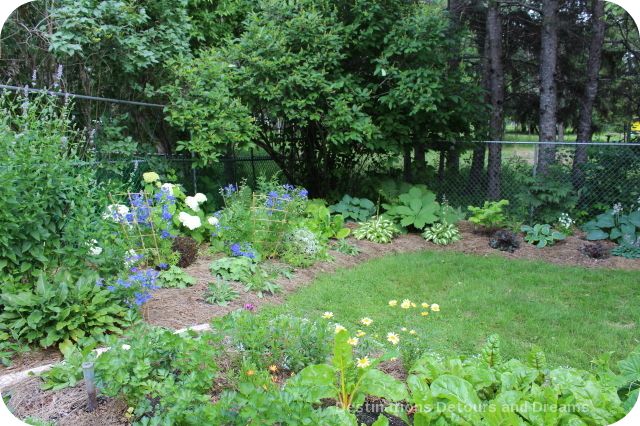
The first two gardens remind me of the possibilities for beauty and growth no matter the environment. The third garden reminds me of the value of working with nature.
For information on the other gardens on the tour, read Nine Reasons to Take a Garden Tour.
Do you have a favourite garden adaptation?
The art of life is a constant readjustment to our surroundings. ∼Kakuzo Okakaura

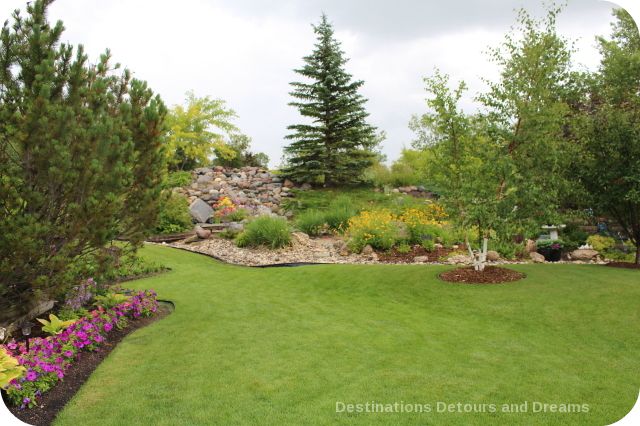
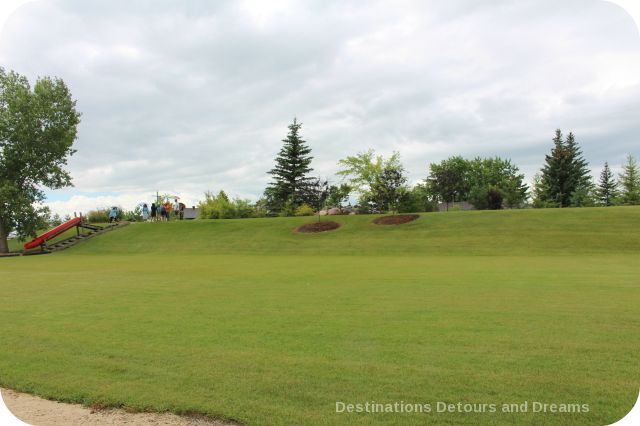
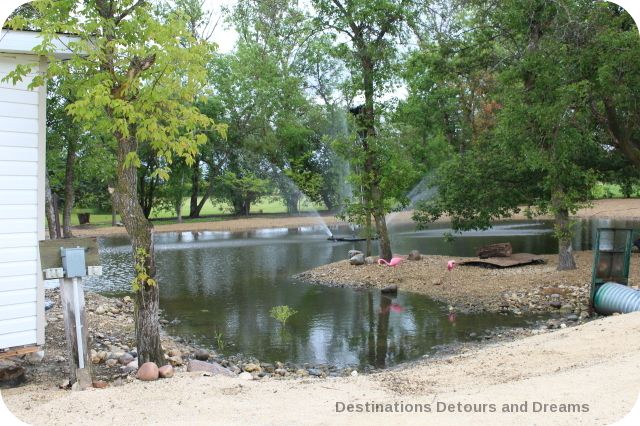
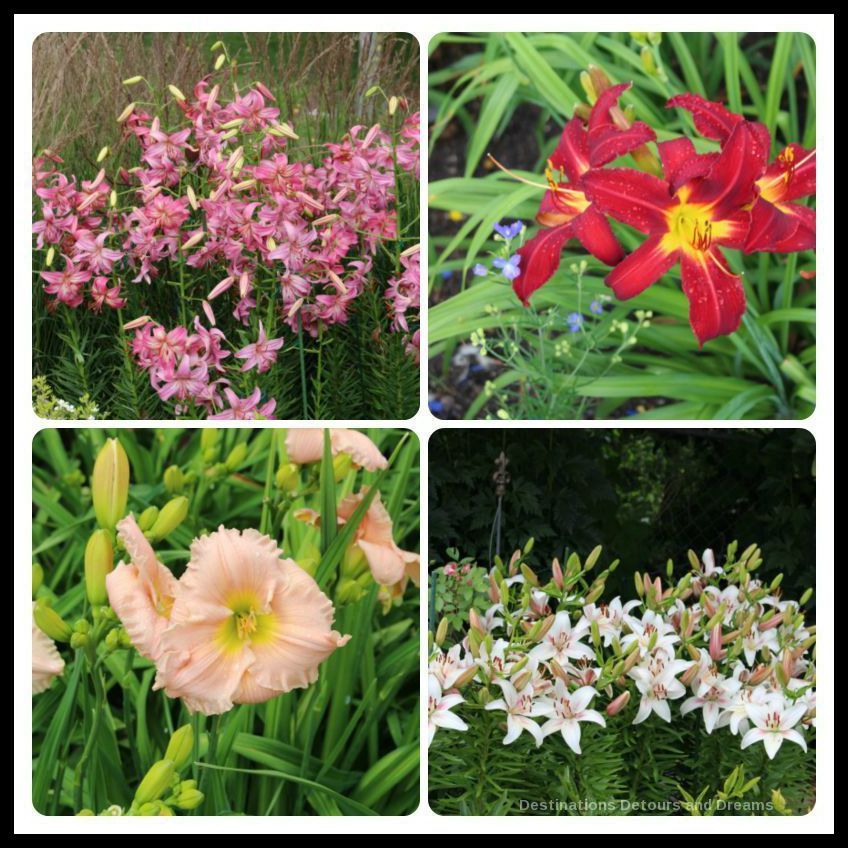
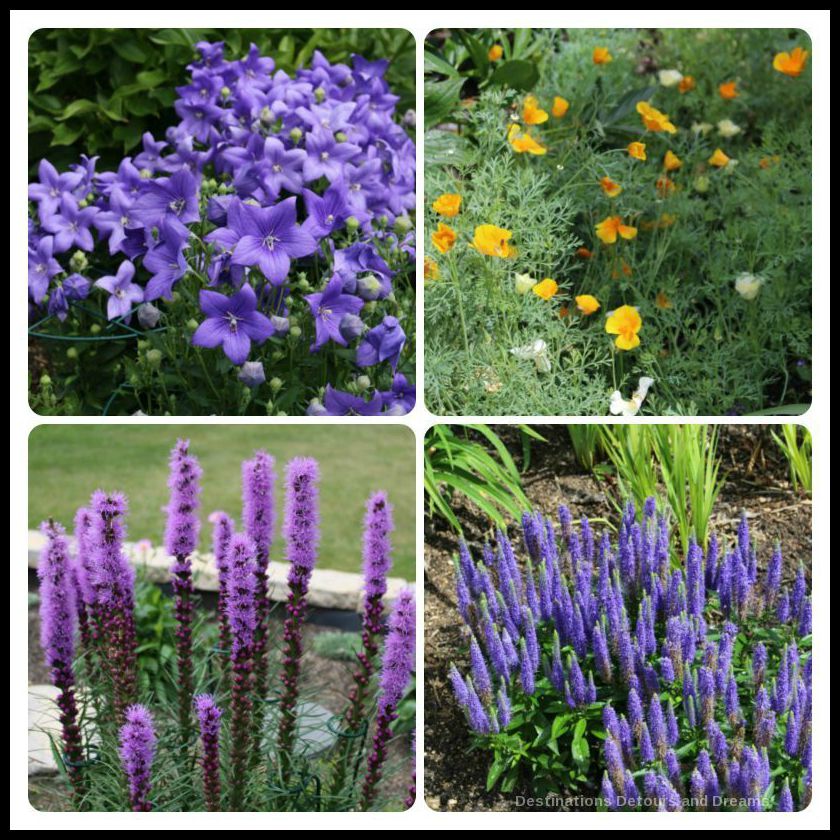
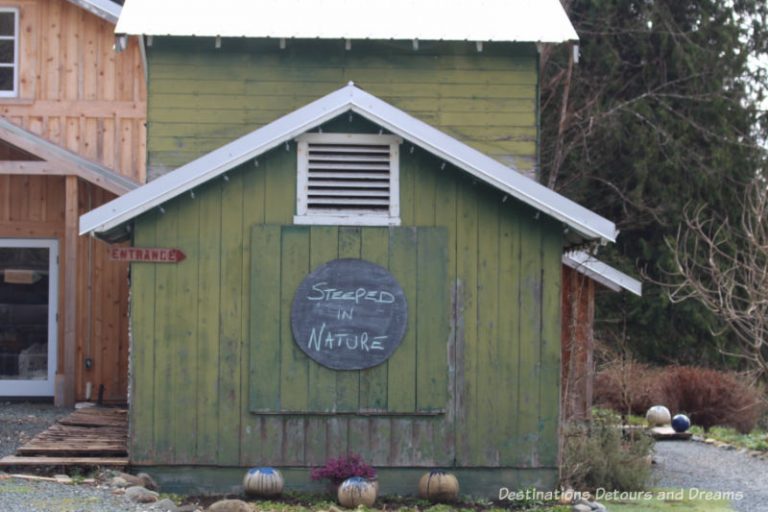


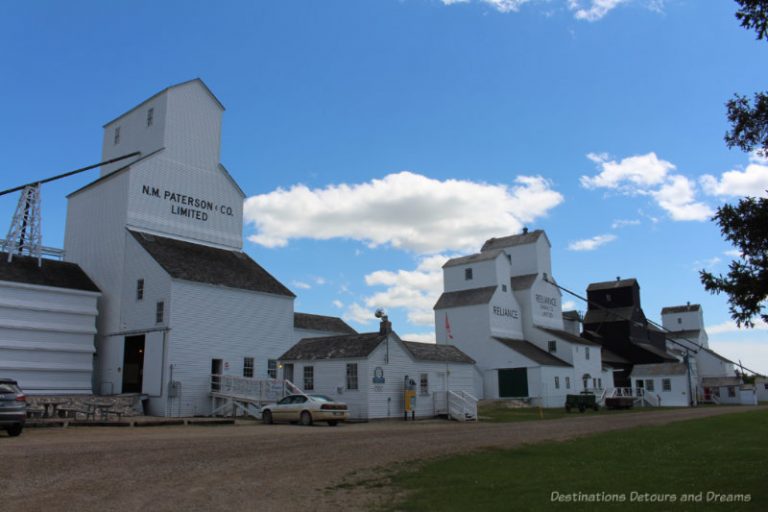


So interesting to read about how these gardeners have worked with what many would see as formidable obstacles to create their own versions of lovely and inviting gardens. Your photos illustrate their creative solutions beautifully. Anita
Thanks Anita.I too found it interesting how these gardeners dealt with what what could have been obstacles to others.
What a wonderful way to work with a problem! The photos illustrate how beauty and function can work hand in hand and be maximized. Really interesting!
Jacquie, I found it encouraging to see how these gardeners worked with their environments and combined beauty and function.
The info you give about lasagna gardening reminds me of something I saw on Shark Tank a while back about a guy who is using newspaper to create humus that actually works better than the real thing and also alleviates the need to go out and harvest it as well (its in dwindling supply). If I had my backyard to do all over again, I would really get into xeriscaping as it boggles my mind how much water I waste. Even though its irrigation water and not city water, I still cringe out how much it takes to keep a lawn green in the high desert during the summer months.
Jeri, I’ve used newspaper in my vegetable garden a few times over the winter. The intent was to reduce the weeds in spring, which only partly worked, but I think it did make the soil better. Another time I laid down wet newspaper under plastic on a part of the lawn where I wanted to get rid of the grass and start a new flower bed. That worked.
I love the idea of the lasagna garden. I might give that a go at home.
Lyn, if I still had my large yard, I would be giving a lasagna garden a try.
You must be a gardener yourself to have woven together this interesting story and to notice the different approaches.
Irene, I have done some gardening over the years, but nothing like these master gardeners.
Very cool post, Donna. I love when people take their unique circumstances and work with them to make the best of the situation. I’ve heard of the lasagna gardening. I imagine it works better than just putting landscaping fabric down to prevent the weeds from overtaking the garden. I found that only after about 3 years, the weeds and grasses overtook the landscaping fabric and I had to start all over again.
Doreen, I suspect the lasagna gardening works better than just laying landscaping fabric, but it takes a bit more time to establish. I also suspect you need to mulch to keep weeds down. If only the plants we wanted to grow were as persistent as the ones we don’t.
Great photos of how one can make the most attractive garden possible, Donna. When there’s a will there’s a way, as they say. Have to admit though that considering that I’m not into gardening I would have to hire someone to do it:-)
Catarina, I’ve had several gardens in the past and am now content with a small flower bed bordering the house. Gardening can be a lot of work. I still like to see what other people are doing.
I have never heard of lasagna gardening so thank you for the explanation. I think this is a great example of using mother nature to protect against mother nature. It really is a bonus that the gardens are so pretty.
Erica, this was the first I’d heard of lasagna gardening as well. I agree it is a great example of working with mother nature.
I am going to keep the lasagna gardening in mind next year for my tomatoes instead of using black plastic. I live in a wooded area so I like to keep things as natural as possible. My tomatoes really struggle but I keep trying. I have researched plants and grass that like to grow in shade. There are so many options out there.
Arleen, there are a lot of options for plants and grasses that work well in shade, but sometimes it takes experimenting and moving plants around a bit to find the ones that thrive best in a particular spot. Good luck with your garden.
What beautiful gardens! The front drives are pretty too.
Gardening looks like sheer hard work which is probably why so many people choose to pay a professional.
Gardening can be hard work, but for many it is a labour of love. Others prefer to pay a professional and devote their energies elsewhere.
Doreen, first thanks for these photos, they’re wonderful. I’ve used the lasagna method for planting under my large maple trees. It’s not a good idea to dig down and disturb the roots so the lasagna method worked great. I did add a layer of topsoil just so I could plant stuff right away. Worked great.
Lenie, it’s nice to hear that the lasagna method worked well for you.
Oh WOW, I love some of these ideas. With the drought we’re struggling with gardening has been a huge challenge. We are in the process of deciding to go to a different kind of garden because of it.
Susan, I can imagine the drought is posing a lot of challenges for gardeners. Good luck with whatever you decide to do with your garden.
Fascinating! I love the idea of the lasagna garden, although I was hoping that meant they were growing all the ingredients for lasagna. 🙂 Here in the desert southwest we all live with xeriscaping, which is gardening adapted to hot and dry climates. I like that it makes the most of what we have naturally, without trying to introduce water-loving plants that wouldn’t do so well here.
Meredith, when I first heard the name lasagna garden, my first thought was also that they were growing ingredients (herbs, etc.) for lasagna. I have seen some lovely xeriscaped gardens in the desert.
As usual, love your photos. I like gardens that aren’t too manicured, that have a rough look to them. They seem more authentic and that’s how a garden would grow anyway, with a certain randomness.
Jeanette, I too prefer a more authentic garden look. Sometimes, gardeners have put a lot of work and effort into producing a garden that looks natural.
What lovely gardens. I loved looking at all of them. I like the idea of lasagna gardening. Good way of making compost.
Mina, it was interesting to see the gardens. Thanks for stopping by.
I love gardens and looking at these pictures reinforces the amount of work, love and passion gardening entaisl. One of the reasons II find gardens so pleasurable is the aura of gardeners love surrounding every bed.
Pamela, well sad – the aura of love is what makes so many gardens special.
A wonderful post. As I stated before I have not had a garden recently. I am planning on one in the spring. I hope your upcoming posts will deal with things we can do in the fall for a garden next year.
William, I’m glad you enjoyed the post, although I don’t know that I will have any fall gardening advice. Unless I find a fall garden tour to attend.
Such beautiful gardens and the stories behind them are fascinating – especially the lasagna gardening because I never heard of such a thing before.
Lasagna gardening was a new concept for me and my friends as well. It seems there is always something to learn about gardening.
Great photos, Donna. I love this lasagna idea and have a couple of new places I’d like to try that in the springtime. Thanks for sharing.
I hope the technique works well for you.